There’s something magical about sipping a cup of homemade chamomile tea made from flowers you’ve dried yourself. This gentle herb has been cherished for centuries not just for its delicate apple-like fragrance but also for its naturally calming properties that help us unwind after long days.
We’ve discovered that drying chamomile at home is surprisingly simple and incredibly rewarding. Whether you’re growing your own chamomile or have access to fresh flowers, learning this traditional preservation method lets you enjoy soothing tea year-round while saving money on store-bought options.
The process requires minimal equipment and transforms those delicate white and yellow blooms into a pantry staple that’ll last for months. We’ll walk you through the foolproof techniques that ensure your dried chamomile retains maximum flavor and potency for the perfect cup of tea every time.
When to Harvest Chamomile for Drying
Timing plays a crucial role in achieving the best flavor and potency from your chamomile flowers. We recommend harvesting chamomile in the morning after the dew has dried but before the heat of the day sets in. This timing ensures the flowers contain optimal levels of essential oils while preventing moisture that could lead to mold during the drying process.
The ideal harvest window occurs when chamomile flowers are fully open and the white petals begin to curve backward slightly. Fresh blooms display bright white petals with vibrant yellow centers that appear plump and full. We avoid picking flowers that show brown edges on the petals or have wilted appearances as these indicate the blooms are past their prime.
Peak harvesting season typically spans from late spring through early fall depending on your growing zone. Most chamomile varieties produce flowers continuously throughout this period when regularly harvested. We find that harvesting every few days encourages the plants to produce more blooms and extends the harvesting season.
Weather conditions significantly impact harvest quality. We always choose dry days for harvesting and avoid picking flowers immediately after rain or during humid conditions. Wet flowers require longer drying times and may develop mold or lose their delicate flavor profile. Clear sunny days provide the best conditions for both harvesting and beginning the drying process.
The fragrance test serves as our reliable indicator of readiness. Fresh chamomile flowers should emit a sweet apple-like scent when gently crushed between your fingers. Flowers lacking this characteristic aroma may not have developed their full flavor potential and should remain on the plant for additional ripening time.
Tools and Equipment Needed

Before we begin the drying process, let’s gather the essential tools that will ensure our chamomile flowers dry properly and retain their delicate flavor profile.
Essential Harvesting Tools:
- Garden shears or scissors for cleanly cutting chamomile flowers
- Basket or bucket to collect the freshly picked blooms
- Clean cloth or paper towels for gentle cleaning if needed
Drying Equipment Options:
- Screen, mesh tray, or drying rack for traditional air drying methods
- Food dehydrator for faster, controlled drying results
- Oven as an alternative when no dehydrator is available
- Paper towels or clean plates for spreading flowers during the drying process
Optional but Helpful Items:
- Fan to improve air circulation in your drying area
- Thermometer to monitor temperature accuracy
- Airtight containers for proper storage after drying
We recommend having multiple drying options available since different methods work better depending on your climate and time constraints. The food dehydrator offers the most consistent results for long term storage, while air drying provides the most natural approach that preserves the flower’s essential oils effectively.
Most of these tools are common household items, making the chamomile drying process accessible without important investment. The key is ensuring whatever method you choose allows for proper air circulation and temperature control to prevent mold while maintaining the flower’s beneficial properties.
Ingredients
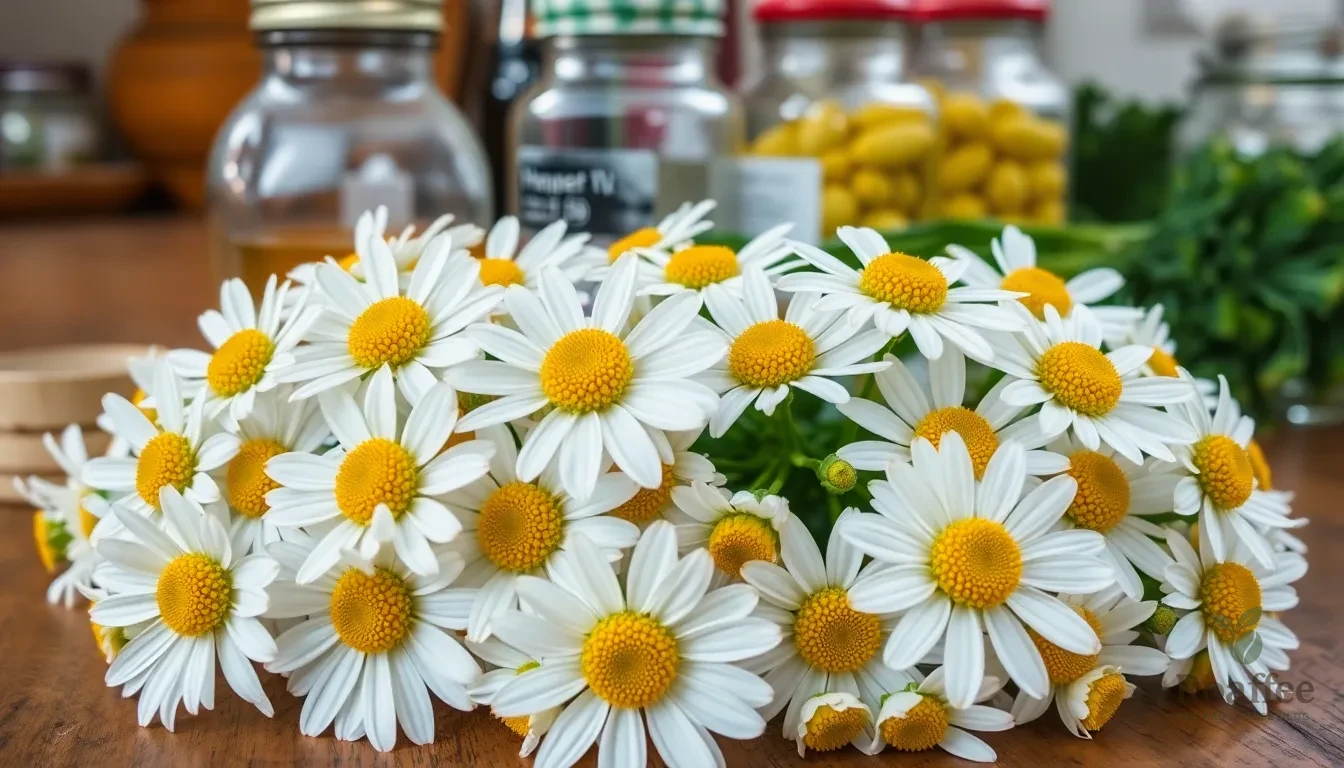
For drying chamomile successfully, we need only the freshest flowers and basic household items. The beauty of this process lies in its simplicity – no special ingredients or additives are required.
Fresh Chamomile Flowers
- Freshly harvested chamomile flowers – Pick flowers that have fully opened but whose centers have not become overly large and petals aren’t drooping
- Optimal timing – Harvest in the morning after dew has dried but before heat dissipates essential oils
Optional Additions for Tea Service
- Honey – For sweetening the finished tea if desired
- Hot water – For steeping the dried flowers into tea
Storage Materials
- Airtight containers – Glass jars or sealed containers for storing dried chamomile
- Labels – To mark storage containers with harvest date
The key ingredient remains the chamomile flowers themselves. We focus on selecting blooms at their peak freshness when essential oils are most concentrated. Fresh flowers should emit a sweet apple-like scent when gently crushed between our fingers.
No preservatives or chemicals are needed in this natural drying process. The flowers retain their calming properties and delicate flavor through proper harvesting and drying techniques alone. Once we complete the drying process, we can create our homemade tea using just the dried flowers and hot water.
Air Drying Method
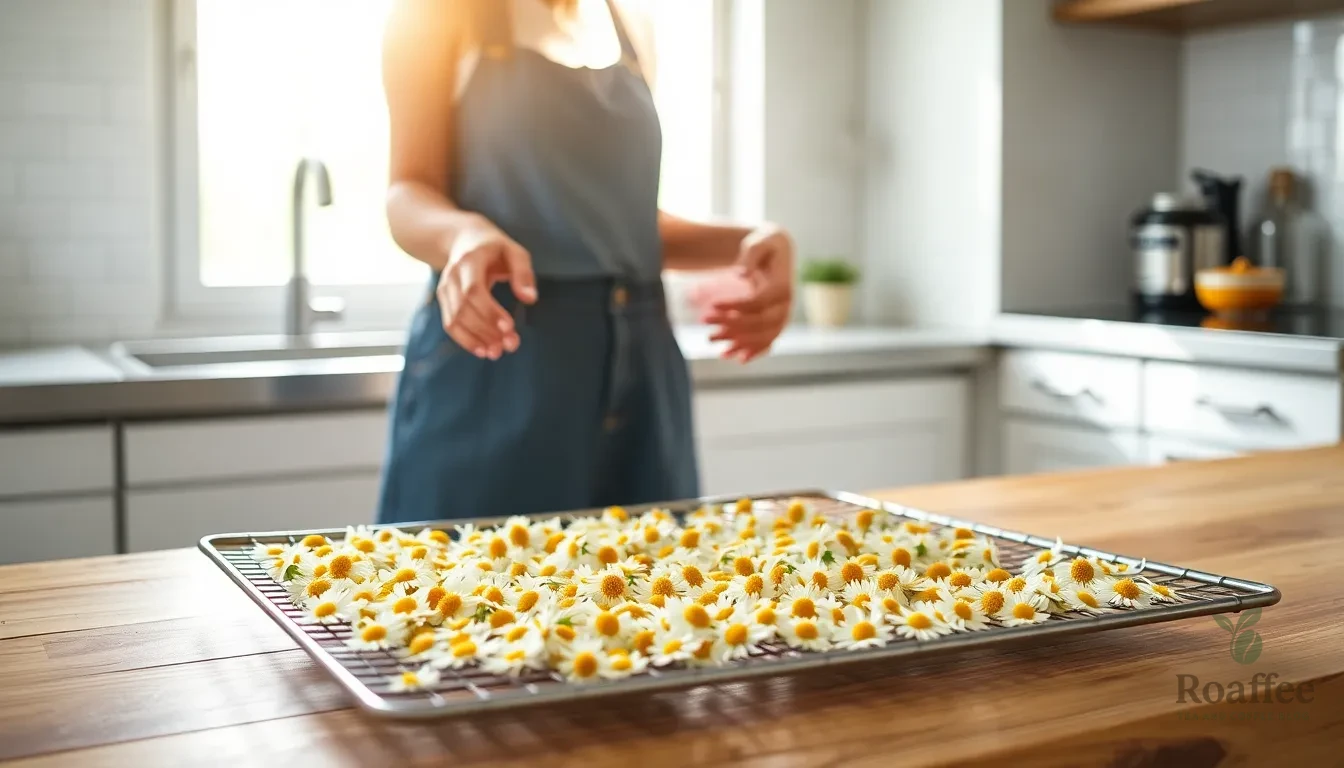
We recommend the air drying method as the most traditional and gentle approach to preserve chamomile’s natural flavor and beneficial oils. This time-tested technique requires minimal equipment while delivering exceptional results for your homemade tea.
Prep the Chamomile Flowers
We begin by carefully examining our freshly harvested chamomile flowers to ensure they meet quality standards. Remove any stems, leaves, and debris from the flowers while checking for insects or damaged petals. Washing the flowers remains optional, but we suggest skipping this step to avoid introducing moisture that could extend drying time or promote mold growth.
Spread the cleaned flowers in a single layer across a breathable surface such as a clean screen, herb drying rack, or cooling rack lined with a tea towel. We ensure each flower has adequate space around it to promote proper air circulation during the drying process.
Bundle and Hang
For an alternative approach, we create small bundles by tying chamomile stems together with string or rubber bands. We hang these bundles upside down in a location that offers warmth, darkness, and excellent ventilation. This hanging method protects the flowers from direct sunlight while maintaining good airflow around each bloom.
Select a drying area away from humidity sources such as kitchens or bathrooms. We prefer spaces like attics, closets, or spare rooms where temperature and moisture levels remain consistent throughout the drying period.
Drying Time and Storage
Our air drying process typically requires 2 to 4 weeks for complete moisture removal from the chamomile flowers. We gently turn or fluff the flowers every few days to ensure even drying and prevent any potential mold formation. The flowers reach completion when they feel completely dry and brittle to the touch.
| Drying Method | Time Required | Environment Needs |
|---|---|---|
| Air Drying | 2-4 weeks | Cool, dark, well-ventilated |
| Screen Drying | 2-4 weeks | Breathable surface required |
| Bundle Hanging | 2-4 weeks | Upside down positioning |
Once fully dried, we transfer the chamomile flowers to airtight containers and store them away from light and moisture. Proper storage preserves the flavor and medicinal properties, ensuring our homemade tea maintains its quality for months to come.
Oven Drying Method
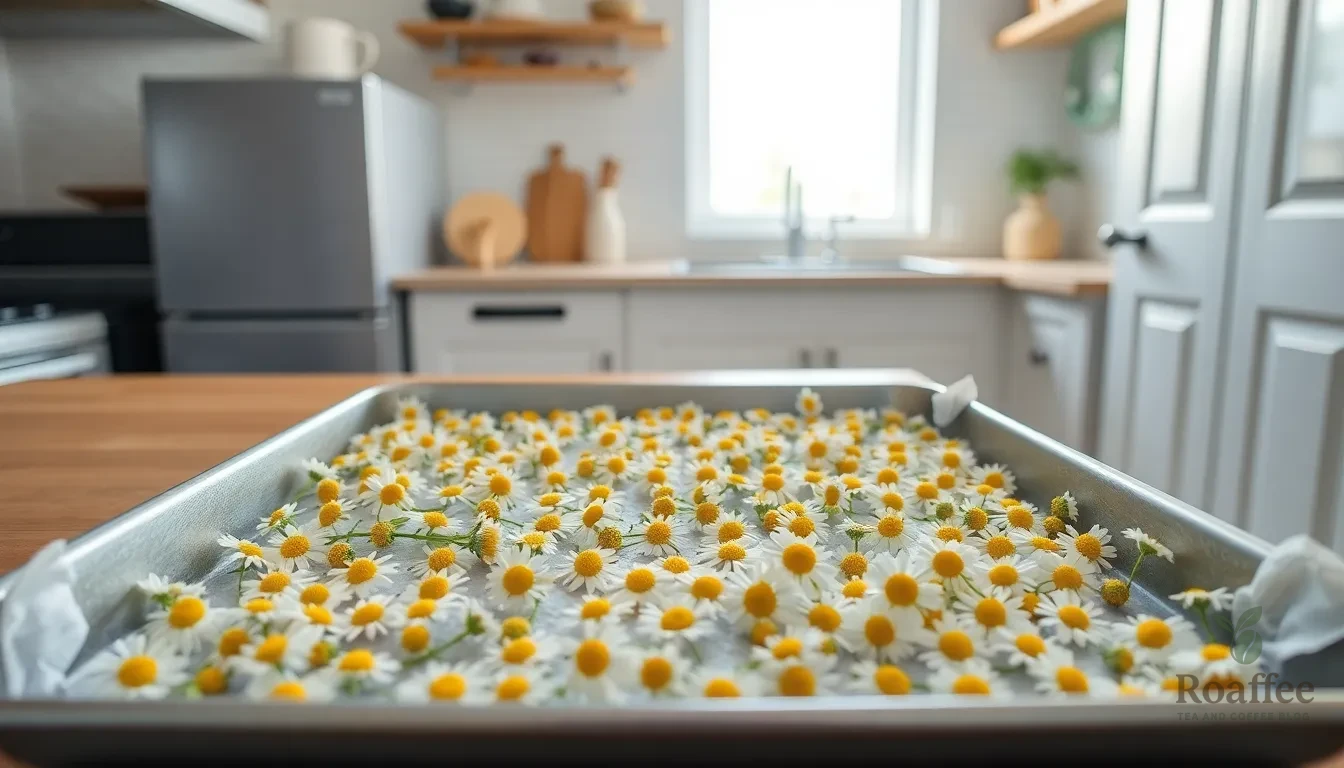
The oven drying method offers a faster alternative to air drying when you need dried chamomile tea quickly or live in a humid climate. This controlled approach delivers consistently dried flowers in just 1 to 2 hours while preserving the essential oils and delicate flavor.
Prep the Chamomile Flowers
We start by selecting chamomile flowers that are fully opened but not aged, harvesting them preferably in the morning before heat dissipates the essential oils. Remove any stems or bugs from the flowers to ensure clean drying material.
We recommend washing the flowers gently under cool water if needed, though this step is optional. After washing, dry them thoroughly with a clean towel or salad spinner to remove excess moisture that could hinder the drying process. The flowers should feel dry to the touch before proceeding to the oven.
Oven Temperature and Setup
Set your oven to the lowest temperature available, typically around 170°F (about 75°C). This low temperature ensures we dry the flowers rather than cook them, preserving their beneficial properties and delicate flavor.
If your oven’s lowest setting runs slightly too hot, prop the oven door open slightly to allow moisture to escape and prevent overheating. Arrange the chamomile flowers in a single layer on a baking sheet to promote even drying throughout the process.
Drying Process
Place the baking sheet with flowers in the preheated oven and dry for 1 to 2 hours. The exact timing depends on your oven’s performance and the moisture content of your flowers.
Check the flowers periodically to avoid burning or overheating, as chamomile can become bitter if exposed to excessive heat. The flowers are ready when they feel completely dry and crisp to the touch. Once dried, allow the chamomile to cool completely before transferring to storage containers.
Store the fully dried chamomile in airtight containers away from light and moisture to maintain quality and potency for months of enjoyable tea brewing.
Dehydrator Method
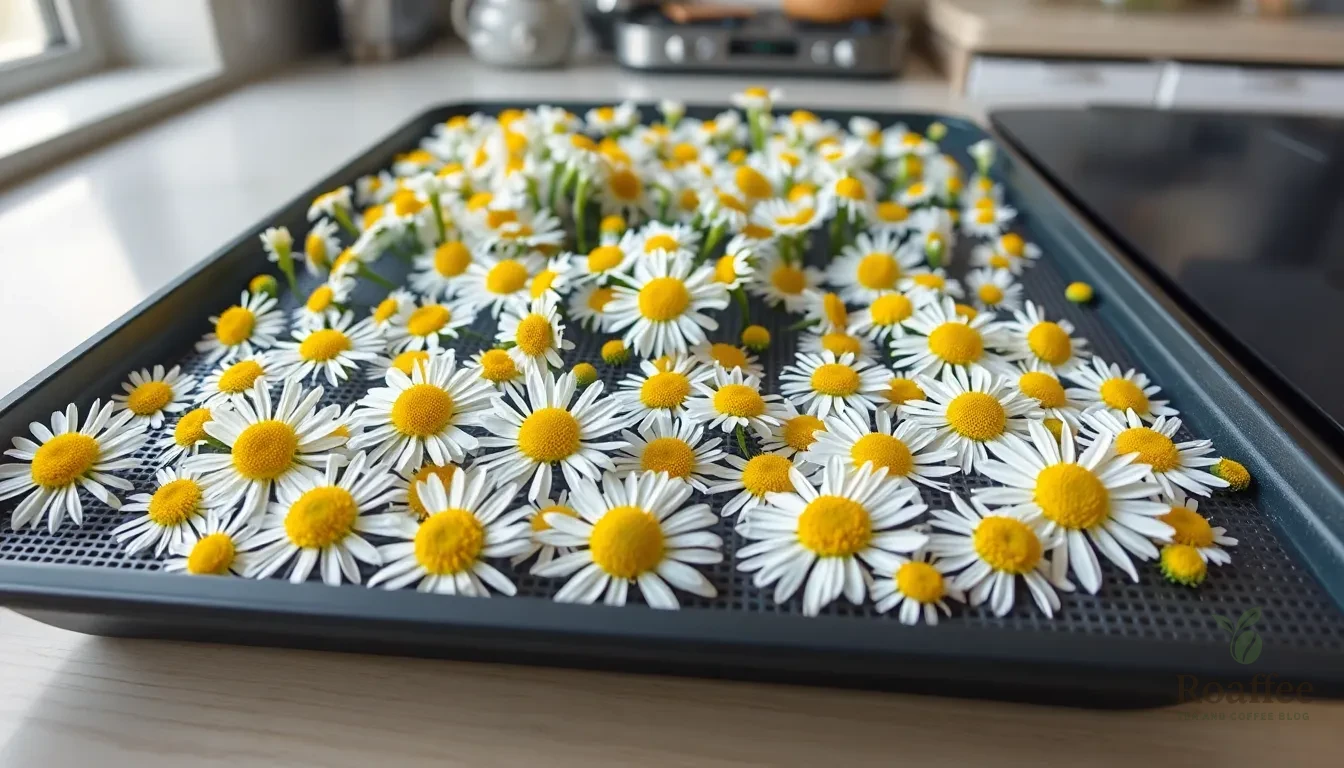
The dehydrator method offers precise temperature control and faster results than air drying while preserving chamomile’s delicate essential oils. We recommend this technique for large batches or when you need dried chamomile quickly.
Prep the Chamomile Flowers
We start by harvesting chamomile flowers when they reach full bloom but before the petals begin to droop. Remove all stems from the flower heads and inspect each bloom for any insects or debris. Gently rinse the flowers with cool water if needed but ensure they are completely dry afterward using a clean towel or salad spinner. Excess moisture can lead to mold formation during the drying process which we want to avoid at all costs.
Dehydrator Settings
Spread the chamomile blossoms in a single layer across the dehydrator trays to ensure even drying throughout the batch. Set your dehydrator to a low temperature between 95°F and 110°F (35°C to 43°C) to preserve the flowers’ delicate aroma and medicinal properties. Higher temperatures will degrade the essential oils and diminish the flavor we work so hard to maintain. The consistent airflow and temperature control make this method particularly effective for achieving uniform results.
Drying Time
| Drying Duration | Temperature Range | Expected Results |
|---|---|---|
| 2-4 hours | 95°F-110°F | Standard drying time |
| Up to 24 hours | Very low heat | Optimal preservation |
The drying process typically takes between 2 to 4 hours depending on your dehydrator’s efficiency and the moisture content of the flowers. Some experts recommend extending the time up to 24 hours when using very low heat for optimal preservation of beneficial compounds. Check the flowers periodically by touching them gently – they should feel completely dry and brittle when ready. Properly dried chamomile will maintain its quality for months when stored correctly and won’t develop mold or spoilage during storage.
How to Test if Chamomile is Properly Dried
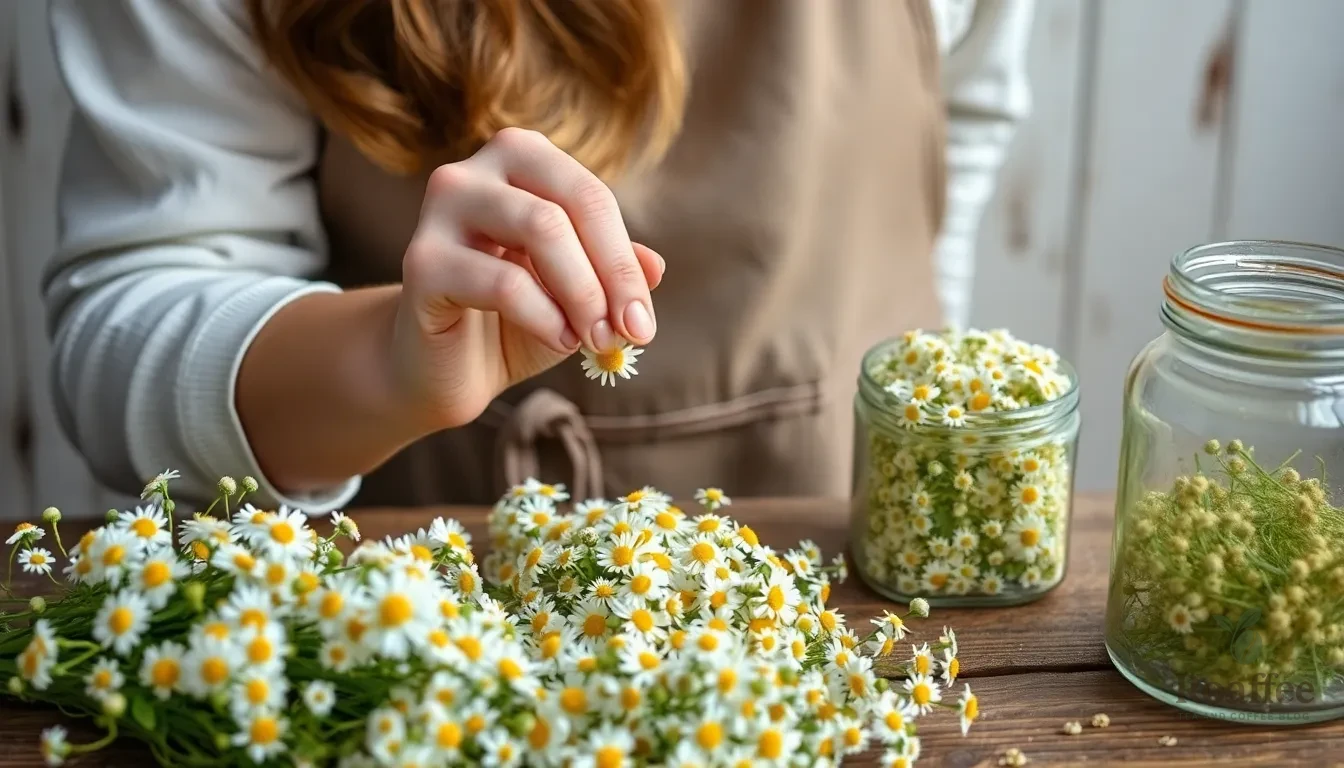
Testing our chamomile flowers for proper dryness ensures we create the best possible tea while preventing mold and spoilage during storage. We can use several reliable methods to determine when our flowers have reached the ideal dryness level.
The Touch Test
Our primary method involves feeling the texture of the dried flowers. Properly dried chamomile should feel completely crispy to the touch with no soft or damp spots remaining. We gently squeeze the flower heads between our fingers to check for any moisture or sponginess. The yellow flower centers require particular attention as they take longer to dry than the white petals. When we press these centers they should feel firm and completely dry throughout.
The Snap Test
We test individual flowers by attempting to snap them between our fingers. Properly dried chamomile flowers will break cleanly with a crisp sound when bent or twisted. Fresh or underdried flowers will bend without breaking or feel flexible when manipulated. This test helps us identify flowers that need additional drying time.
Visual Inspection
Our visual assessment focuses on color and appearance changes. Dried chamomile flowers maintain their white petals but may appear slightly more papery than fresh blooms. The yellow centers should look concentrated and deep in color rather than pale or translucent. We avoid flowers showing any signs of browning or discoloration as these indicate over-drying or potential spoilage.
The Crumble Test
We take a small sample of our dried flowers and crumble them gently between our palms. Properly dried chamomile will break apart easily into small pieces without releasing any moisture. The fragments should feel light and airy rather than dense or sticky. This test also allows us to assess the aroma strength which should remain sweet and apple-like even after drying.
| Test Method | What to Look For | Signs of Proper Drying |
|---|---|---|
| Touch Test | Texture and firmness | Crispy feel, no soft spots |
| Snap Test | Breakage pattern | Clean break, crisp sound |
| Visual Inspection | Color and appearance | White petals, deep yellow centers |
| Crumble Test | Fragmentation and aroma | Easy crumbling, sweet scent |
Storage Readiness Check
Before storing our dried chamomile we perform a final moisture assessment. We place a small sample in an airtight container for 24 hours and check for any condensation on the container walls. The absence of moisture buildup confirms our flowers are ready for long-term storage. Any signs of condensation indicate we need additional drying time to prevent mold growth during storage.
Storing Dried Chamomile
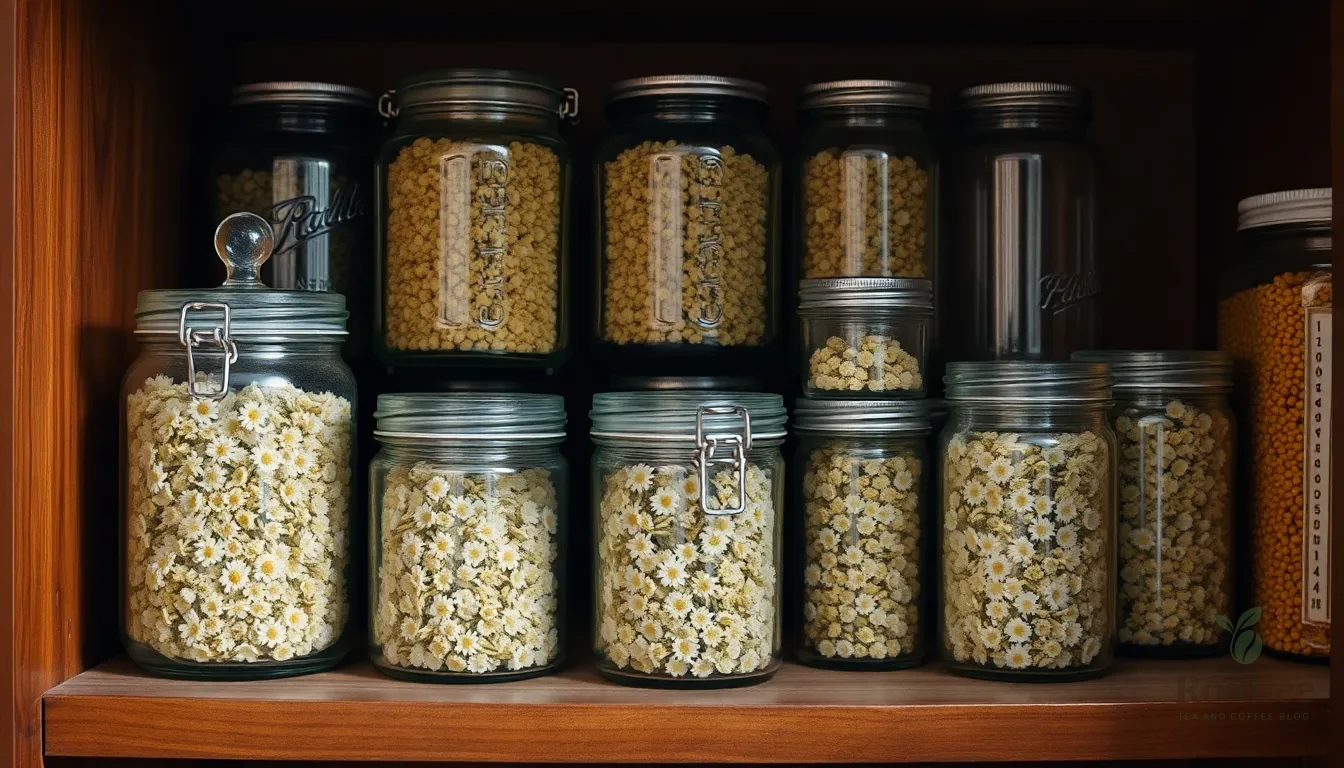
Once our chamomile flowers are fully dried we need to store them properly to maintain their delicate flavor and beneficial properties for up to one year. Proper storage prevents moisture absorption and preserves the essential oils that make chamomile tea so soothing and aromatic.
We recommend using airtight containers as our primary storage method. Glass jars with tight-fitting lids work exceptionally well because they protect against moisture and light while allowing us to see the contents. Mason jars or recycled spice jars provide excellent options for most home storage needs.
Container Selection Guidelines:
| Container Type | Benefits | Best For |
|---|---|---|
| Glass jars | Airtight seal, prevents light exposure | Long-term storage |
| Food-grade plastic containers | Lightweight, stackable | Short-term use |
| Vacuum-sealed bags | Space-efficient, maximum freshness | Large batches |
Dark storage locations preserve the chamomile’s potency better than bright areas. We should place our containers in pantries, cupboards, or other cool spaces away from direct sunlight. Heat sources like stoves or heating vents can degrade the quality over time.
Temperature control plays a crucial role in maintaining freshness. Room temperature storage works best, typically between 60°F and 70°F. Extreme temperature fluctuations can cause condensation inside containers, leading to mold growth and spoilage.
Labeling our containers with harvest dates helps us track freshness and use older batches first. We can include additional information like the drying method used or exact flower variety if we grow multiple types of chamomile.
Storage Best Practices:
- Fill containers completely to minimize air exposure
- Check stored chamomile monthly for any signs of moisture or mold
- Keep containers tightly sealed after each use
- Store away from strong-smelling foods that might affect the delicate chamomile aroma
Properly stored dried chamomile retains its sweet apple-like fragrance and maintains its calming properties throughout the storage period. We can expect our carefully dried and stored chamomile to provide excellent tea quality for 12 months when these storage guidelines are followed consistently.
How to Make Chamomile Tea from Dried Flowers
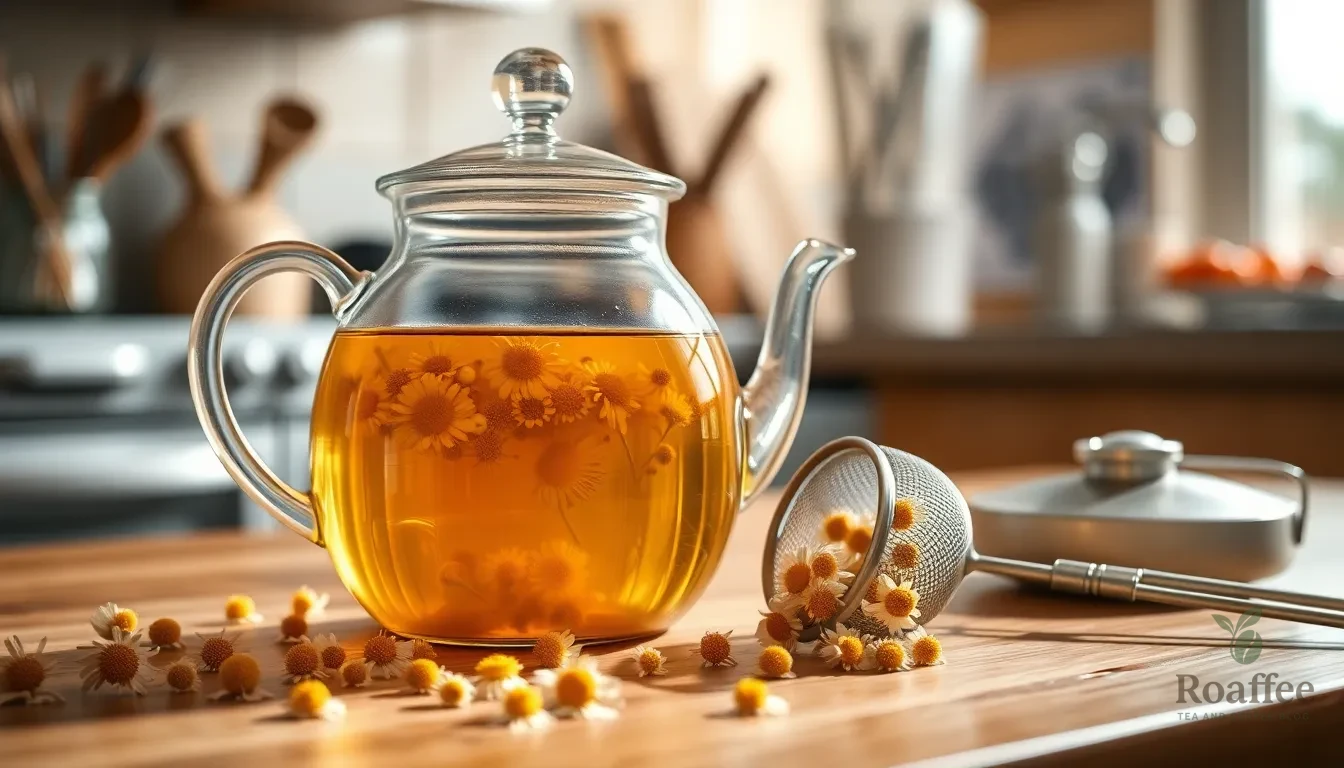
Our carefully dried chamomile flowers create the perfect foundation for a soothing cup of tea that delivers stronger flavor than fresh flowers due to the concentrated blooms. The brewing process transforms these preserved flowers into a golden liquid that captures all the essential oils and beneficial compounds we worked to preserve during drying.
Measuring and Preparing Your Dried Chamomile
We start by measuring approximately 1 teaspoon of our dried chamomile flowers per cup of tea. This ratio provides the optimal balance of flavor and therapeutic benefits without overwhelming the delicate taste. The flowers should feel completely crisp and crumble easily between our fingers when properly dried.
Steeping Instructions
Water temperature plays a crucial role in extracting the best flavors from our dried chamomile. We heat water to just below boiling point, around 200°F to 212°F, which allows the flowers to release their essential oils without becoming bitter. Fresh filtered water enhances the tea’s clean taste and prevents any unwanted mineral flavors from interfering with the chamomile’s natural sweetness.
Pour the hot water over the dried flowers in a teapot or cup, ensuring all flowers are fully submerged. Cover the vessel to trap the aromatic steam and prevent the volatile oils from escaping during the steeping process.
Steeping Time and Strength
Our dried chamomile requires 4 to 5 minutes of steeping time to achieve the perfect balance of flavor and potency. Shorter steeping times produce a milder tea, while longer periods intensify the apple-like flavor and increase the concentration of beneficial compounds. We recommend starting with 4 minutes and adjusting to personal preference.
Serving Suggestions
| Enhancement | Amount | Purpose |
|---|---|---|
| Honey | 1-2 teaspoons | Natural sweetener |
| Lemon slice | 1 thin slice | Adds citrus brightness |
| Fresh mint | 2-3 leaves | Complementary herb flavor |
Strain the tea through a fine mesh strainer to remove all flower particles before serving. The finished tea should display a beautiful golden color with a sweet, apple-like aroma that immediately signals its quality and freshness.
Storage of Brewed Tea
Fresh chamomile tea tastes best when consumed immediately after brewing. We can store leftover tea in the refrigerator for up to 24 hours, though the flavor will gradually diminish over time. Reheating gently on the stovetop or in the microwave restores the tea’s warmth without destroying its beneficial properties.
Conclusion
Drying your own chamomile opens up a industry of soothing homemade tea that’s both cost-effective and rewarding. Whether you choose air drying for its traditional approach or opt for faster methods like oven or dehydrator drying, you’ll have fragrant dried flowers ready for brewing.
The key to success lies in proper timing during harvest and ensuring complete dryness before storage. With the right techniques and storage methods, your dried chamomile will maintain its sweet apple-like fragrance and calming properties for up to a year.
Now you’re equipped with everything needed to transform fresh chamomile flowers into a pantry staple that’ll provide countless cups of relaxing tea. We’re confident you’ll enjoy the satisfaction of sipping tea made from flowers you’ve dried yourself.
Frequently Asked Questions
When is the best time to harvest chamomile flowers for drying?
The optimal time to harvest chamomile is in the morning after the dew has dried but before the heat of the day. This timing ensures maximum essential oil levels and prevents moisture-related issues. Pick flowers that are fully open with slightly curved petals, avoiding those with brown edges or wilting. The peak season runs from late spring to early fall.
What tools do I need to dry chamomile flowers?
You’ll need basic garden shears or scissors for cutting, a basket for collection, and a clean cloth for gentle cleaning. For drying, use a screen or mesh tray for air drying, a food dehydrator for faster results, or an oven as an alternative. Most tools are common household items, making the process accessible without significant investment.
How long does it take to dry chamomile flowers?
Drying time depends on your chosen method. Air drying takes 2-4 weeks in a warm, dark, well-ventilated area. Oven drying is fastest at 1-2 hours at 170°F. Dehydrator drying takes 2-4 hours at 95-110°F, though some experts recommend up to 24 hours at very low heat for optimal preservation.
How do I know when chamomile flowers are properly dried?
Test dryness using several methods: the touch test (flowers should feel completely dry and crisp), snap test (stems should break cleanly), visual inspection (no moisture visible), and crumble test (flowers crumble easily). Place a sample in an airtight container for 24 hours to check for condensation before final storage.
How should I store dried chamomile flowers?
Store dried chamomile in airtight containers like glass jars in dark, cool locations away from direct sunlight and heat sources. Label containers with harvest dates. Properly stored dried chamomile retains its sweet apple-like fragrance and calming properties for up to 12 months when following these storage guidelines.
How do I make tea from dried chamomile flowers?
Use about 1 teaspoon of dried chamomile per cup of tea. Heat water to just below boiling and steep for 4-5 minutes. Dried flowers yield stronger flavor than fresh ones. Enhance with honey, lemon, or fresh mint if desired. Brewed tea is best consumed immediately but can be refrigerated for up to 24 hours.


















